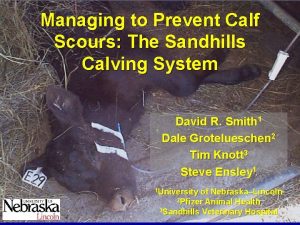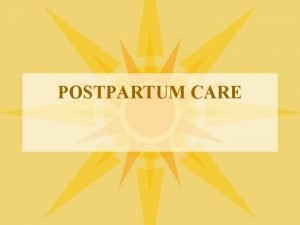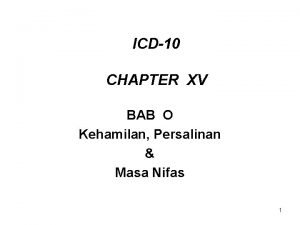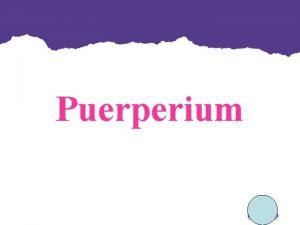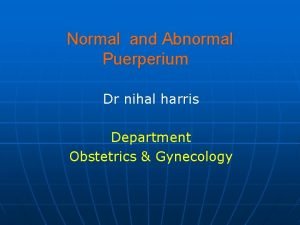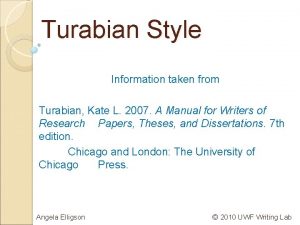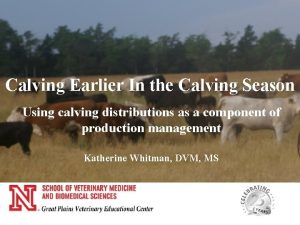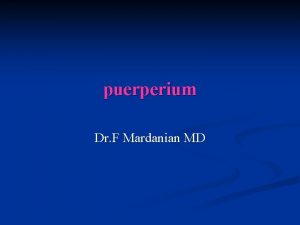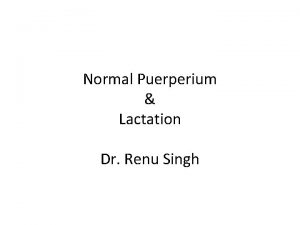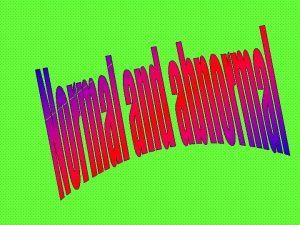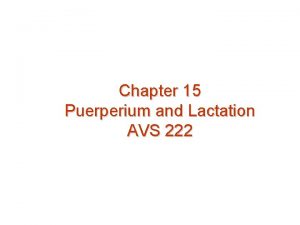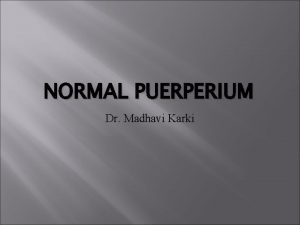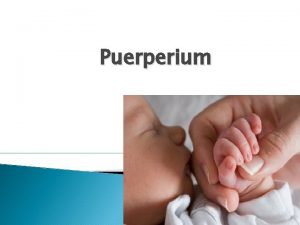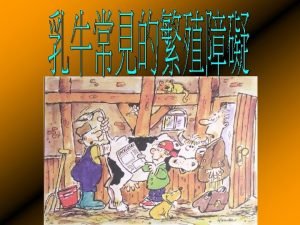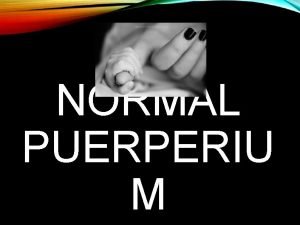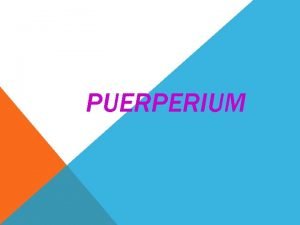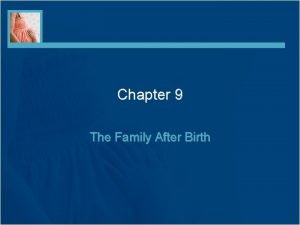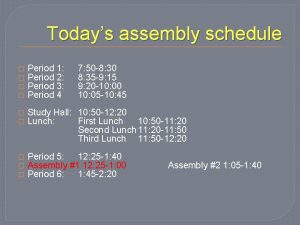puerperium Definition The period after calving when the






















- Slides: 22

puerperium

Definition: The period after calving when the genital organ are returning to their non pregnant state. Important changes occurduring the puerperium 1 -shrinkage of the uterus to its normal non pregnant state 2 -regeneration of the endometrium 3 -elimination of bacterial contamination 4 -return to normal cyclical ovarian activity

the duration of puerperium In cow : about 75 days In small ruminant : as cow In mare : about 9 days

Uterine discharge{lochia} Definition: It is discharge which escape from uterus during the period of puerperium. Composition: It consist of blood fibrin , parts of the placenta , fetal fluid , epithelium & mucous

Animals Color odor Consitancy Cattle After delivery: Brown red After aweek: Chocolate At the end of puerperium: clear Odorless After delivery: sticky mucoid After aweek: Thiner and mixed with flakes At the end of puerperium: Glassy mucoid Mare After birth: It is red brown then it start to change to brown, yellowish odorless mucoid Small ruminant Blood mucoid at first then it change to be turbid odorless mucoid bitch Greenish black due to presence of bile like pigment called{uterovirdin} odorless mucoid

Closure of the cervical canal The external os is closed less rapidly than internal os On 3 rd day postpartum the external cervical os can pass one hand , while the internal os admits only 2: 3 fingers At the end of the 1 st week the external os admits 1: 2 finger while the internal os can only pass astraw

Factor influencing the rate of uterine involution -Parity : involution is likely to be more rapid in primipara than pluripara. -Season of the year: involution is propbably quicker in spring and summer –calving cows -Suckling: possibly hastens involution -Climate: affect on involution -Suckling intensity and milking frequency : the greater the frequency of milking and intensity of suckling the longer the aperiod of cyclicity

Pathology of puerperium Disturbance of puerperium may result from: -Atony of the uterus -retention of the placenta -Prolapse of vagina or uterus - injury in birth way - infection or intoxication.

Retention of the placenta Primary retention of the fetal membrane result from a lack of detachment from maternal caruncle. Whereas secondary retention is related to amechanical difficulty in expelling already detached fetal membrane



Causes f retention of placenta They are classified into 2 main categories: 1 - interference with normal loosening and separation process between the maternal caruncle and fetal cotyledon a) Immature placentom b) edema of chronic villi c)prolonged gestation d) hypermia of placentom e) Necrosis of placentomes f) Placentitis and cotyledonitis 2 - uterine atony {inertia} Hydropsy , twining , dystocia & hypocalcemia

Another classification of the causes The causes are classified into : infectious , hormonal & nutritional 1 - infectious causes: a) Non specific infection Retained placenta and metritis Retained placenta and mastitis Retained placenta and laminitis Retaind placenta and hypocalcemia

b) Specific infections 1 - bacterial causes Brucellosis , leptospirosis 2 - viral causes IBR , BVD 3 -parasitic infestation Coccidial parasite called neospora like abortion in cattle

2 - hormonal causes a) E 2 & P 4 Higher level of the serum P 4 and lower level of E 2 observed in cow with retained placenta b) prostaglandins Cow with retained placenta has less synthesized Prostaglandin F 2 alpha from their fetal cotyledon

3 -Nutritional causes: Nutritinal causes of retention are due to diet feeding the last 6: 8 Wks before calving The dietery deficiency of imblance of energy , protein , iodine , vit A , D , E are caused of retention placenta

Treatment of retained placenta 1 - manual remove 2 -manual remove with antibiotics Oxytetracycline Sulphonamide Lugol solution 3 - theraputic treatment using stimulants without manual remove Oxytocin , E 2 , prostaglandine , ergot derivative &Ca preparation

Prevention and control of retained placenta 1 - proper feeding program duringg the dry period VIT E & Se Inject 50 mg of Se to buffalo in last month of pregnancy reduce the incidence of retained placenta 2 -Hyginic procedure at the time of birth 3 -Minimize stressful condition 4 -Maintain vaccination program against infectious causes

Secondary retention of the placenta in mare It occurs very seldom in the mare , it mostly occurs after abortion in 6: 9 Mo Causes : It is caused by acute placentitis The bacterial infection during pregnancy doesnot result in retention of the placenta but looseness of allanto chorion because the tuft is very fine resulting in abortion

Symotoms: It is considered as acase of secondary retention of the placenta after 2 hour The mare is restless and strains too much.

therapy The removal of placenta is done by -Very nice washing of the outer genitalia with water and soap -take hold of protruding placenta out of the vulva with left hand -introduce the right hand between placenta and the wall of the uterus seperating the fetal membrane from the endometrium

-remove the whole placenta at one time and donot leave any part of it -wash the uterus with awarm solution of mild antiseptic as betadine -put full dose of antibiotic ttt in uterus -Give dose of anti tetanic serum as prophylaxis -treatment symptomatically any other symptom
 Sandhills calving system
Sandhills calving system Reva rubin scale
Reva rubin scale Icd 10 bayi kembar
Icd 10 bayi kembar Management of puerperium
Management of puerperium Galactokinesis definition
Galactokinesis definition Dr nihal harris
Dr nihal harris After me after me after me
After me after me after me John 14:1
John 14:1 The development of children 7th edition
The development of children 7th edition A&p flix activity: propagation of an action potential
A&p flix activity: propagation of an action potential Is hyperpolarization the same as refractory period
Is hyperpolarization the same as refractory period Critical period vs sensitive period
Critical period vs sensitive period Critical vs sensitive period examples
Critical vs sensitive period examples Critical period vs sensitive period
Critical period vs sensitive period 1750s music
1750s music What element is nonmetal halogen family atomic mass 35
What element is nonmetal halogen family atomic mass 35 The period of activism 1970 to 1972
The period of activism 1970 to 1972 Stability period vs measurement period
Stability period vs measurement period Trustee period and royal period
Trustee period and royal period Written records in history
Written records in history Are footnotes before or after period
Are footnotes before or after period How to use ibid in footnotes
How to use ibid in footnotes State two advantages of cyclical menu
State two advantages of cyclical menu
